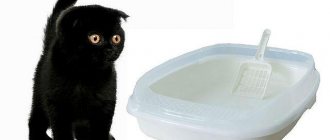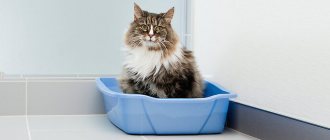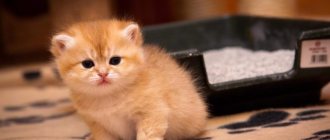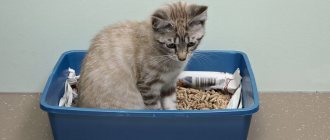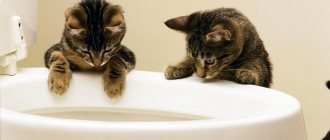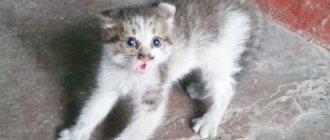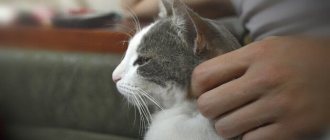In the event that an adult meowing creature appears unplanned in your apartment, as a rule, a huge number of questions arise that must be resolved as quickly as possible. For example, one of them sounds like this: how to train an adult cat to use a litter box?
For many cat owners, the animal’s refusal to use the litter box becomes a significant incentive to achieve their goal.
People often believe that male cats place their scent marks outside the litter box as revenge on their owner. However, this is not always the case. It’s just that, as a rule, in this way the pet “fights” something that worries him. By spreading its scent, which is soothing for it, throughout the house, the animal thereby, as it were, eliminates the imaginary cause of its worries. One of the factors causing anxiety in a pet can be either the mating season (if the cat is not castrated or the cat is sterilized), or an unacceptable atmosphere for the animal in certain places in the apartment. Despite the above, you should not panic if you were unable to solve a household problem the first time - how to train an adult cat to use the litter box.
It is important to choose the right place for your cat to go to the toilet.
Owner mistakes
How to potty train a kitten at home or in an apartment is a whole problem for owners. Some people mistakenly think that:
- With age he will learn on his own. The owner patiently removes the “traces”. The kid considers this normal and concludes that shit can be done everywhere in the house. Time passes, running around with a rag gets boring, and the owner begins to teach the pet, or rather punish it. The cat is perplexed. What is he doing wrong?! After all, the owner himself made it clear that the entire apartment could be used to relieve needs. Conclusion - the sooner you start training (on the first day of arrival in the house), the faster the result will be.
- Everywhere he shits out of spite. The baby himself is not aware of this. The only thing he knows is that he needs to go to the toilet in a secluded place. The owner looks for these places, hits them, pokes them with his nose. So we need to look for something more hidden. Conclusion - the cat shits and pees anywhere because the necessary conditions have not been created.
Toilet as a “health indicator”
An obedient animal stopped going to the potty - a sign that the pet might be sick. Diseases directly related to the toilet include cystitis, inflammation of the ovaries, uterus, bladder stones and other diseases of the reproductive system. A hormonal surge, the natural nature of a pet seeking love pleasures with the opposite sex, also leads to marks being left in unidentified places. In this case, puddles and heaps can be seen closer to the exit from the house. The problem can be easily eliminated by surgical removal of the reproductive organs (sterilization, castration).
Kittens are different
Respectable breeders and large nurseries do not give away litters younger than 2.5-3 months. From 1 month they begin to accustom kittens to the tray. As a rule, at 2 months babies are already accustomed and regularly go to the right place.
In addition, from birth they learn from their mother where to go to the toilet and how to bury feces. When a child arrives in a new home, it is enough to show him where the toilet is 1-2 times, and he will go there regularly.
The problem arises with kittens taken from their mother early. They just don't understand what they need to do. The process of toilet training a one-month-old kitten without a cat takes longer.
A street cat who sees such a device for the first time will have to teach it on his own. And it doesn't always come easy. It is more difficult for him to understand what is required of him.
In order to quickly accustom a kitten to the tray, and some teach it to go to the toilet, you will need patience, perseverance, the right place, filler and the toilet itself.
Algorithm for potty training a kitten
If you want to toilet train your pet, you can use the following algorithm:
- To begin, choose a location for the tray;
- After sleeping or eating, take the kitten to the litter box. The animal’s body is designed in such a way that after eating, the pet begins to want to go to the toilet;
- Hold the kitten carefully. If he starts rowing with his paw on his own, show him that this can be done in the tray;
- If your pet relieves itself, be sure to praise it. At the same time, speak in a gentle tone;
- Even if the baby did things correctly, it does not mean that he remembered and understood where to go to the toilet. You can train your pet using another method. When your pet makes a puddle in the wrong place with a napkin, blot it with a napkin and then put it in the tray;
- To wean a kitten from going to the toilet in the wrong place, you need to carefully treat the puddle. For this, there are special products that remove odor and enzymes;
- Next time, if a similar situation happens, take the baby to the tray without unnecessary screaming. By the smell, he will understand that he needs to relieve himself there. Be sure to praise the animal;
- You can use special means that attract the kitten to the tray;
- When you are litter training your pet, it is important to choose the right cat litter. But the key to success will be its correct use.
When choosing litter for the toilet, make sure that the cat gets used to it in stages. To do this, you can first lay the diaper with which you wiped the puddle on the bottom. This way you will not only preserve the smell, but will also be able to gradually accustom the kitten. Then take the filler and gradually, every day, add it to the tray. At first you can place it in one corner. After the kitten can go to the toilet, the next day, add the product in another corner. This method of training may take about a week. Gradually, as you add litter to the tray, you will notice that the kitten begins to rake it in. This is how a natural reflex works.
Sometimes the opposite happens - the kitten may not like the toilet product. In order not to make a mistake with your choice, we recommend that you do not buy a large pack at once. We hope that knowing all the nuances will help you teach your pet to use the potty.
How to litter train a kitten
For a small and adult cat, new living conditions are stressful. Kittens refuse to eat, hide, and tremble all over. Animals, in order to get comfortable, begin to mark their territory, including the smell of urine. Therefore, when a baby finds himself in new conditions, he needs the care that his mother gave him. These functions must be assumed by the owner. Feeling care, attention and love, the kitten quickly adapts to a new environment.
The question of at what age to start training disappears - from the moment of appearance in the house.
Acquaintance
During the first days, it is better not to leave the kitten alone. It is advisable to limit the cat's space to one room where you can place bowls and toiletries.
Adaptation of a kitten to a new home
Many kitten sellers assure future breeders that the kitten is already accustomed to a tray and even a scratching post. This may be true, since many skills, habits and manners are instilled in their babies by a cat mother.
After a change in their usual environment, kittens, left without their mother, act according to circumstances and the useful skills they have already acquired may be lost. If the kitten is impatient, he will pee and pee in any place convenient for him, since he cannot yet fully control his natural urges.
It is useless to scold or punish a mustachioed pet. This will only embitter the kitten, and he will stop trusting you. The period of adaptation and socialization in the new home should take place with maximum comfort for the animal.
There are three types of trays for cats:
- With grill;
- Without bars.
- Closed type (toilet house).
In use, as practice shows, trays with bars are more convenient for many cats. Liquid feces pass through the grate and settle at the bottom. The paws and fur will remain clean after he has gone to the toilet in a small way.
In addition, many cats shit only because their paws get wet in the litter box during elimination. There are also individuals who do not like to go potty with any kind of litter, so also take this aspect into account.
When choosing where to place the tray, use the following tips:
- Place the pot in an accessible place. The cat must have constant access to its toilet.
- Do not place the urinal near heating or household appliances that make noise or loud sounds. The tray should not be placed near a battery, refrigerator, or washing machine.
- Do not place the tray in the aisle. Place it in a secluded, quiet place, for example, in a remote corner of the room, hallway, or bathroom.
Advice! Breeders recommend purchasing several trays at once and placing them in different places. Observe where the kitten likes to go the small way or the big way the most. Place the cat litter box there.
How to train an adult cat to use the litter box
Cats love cleanliness and will willingly use a litter box if they have access to it, and some will immediately take a liking to the toilet. Even an outdoor cat will be happy to go to a tray that is in a secluded place and is the right size.
The method for potty training a cat is the same as for kittens - when you bring an adult animal home, you need to introduce it to the toilet by placing it there. It is advisable to spend the first 2 days with the cat and, if you notice attempts to sit in the wrong place, take it to the litter box.
But not everyone manages to avoid mistakes in the first days. Main:
- Do not punish or beat the animal.
- It is advisable to transfer waste from the crime scene to a tray and show the animal where it went.
- It is important to thoroughly wash away any traces left behind.
Cats have a highly developed sense of smell, and if the smell is not neutralized, they will definitely return to the same place to defecate there again. To eliminate the “aroma” you can use specially developed preparations. For example, Laine or household chemicals, but without ammonia. Because for cats, the smell of ammonia is similar to the smell of their urine.
Learning process
Depending on the age of the animal, the learning process has its own characteristics. And although there is an opinion that it is impossible to train an adult cat to the toilet, my experience says otherwise. I share lifehacks below.
How to train a kitten
- Buy a suitable small tray. Place it in a separate room where other animals will not have access.
- If you buy a kitten from a breeder, most likely the baby already has an idea of how to relieve itself. Ask the breeder for a handful of the litter they use on their animals, or ask the manufacturer. Purchase and pour into a tray. The kitten will intuitively relieve itself where it should be.
- Monitor your kitten's behavior: most often they go to the toilet after sleep and immediately after eating. If the baby sniffs and scratches with his paw, this is a sure sign that it’s time to take him to the right place.
- Place your pet in the tray, pet it and wait until it does its business.
- After this, praise him and give him a treat.
How to train an adult cat
- If you adopted an adult animal from the street, you will need a larger tray.
- At first, you can use earth or sand instead of litter, especially if you can take it from places familiar to your pet. Yes, this is not entirely convenient when cleaning, but it greatly facilitates the learning process.
- Adult animals go to the toilet less often than babies, so you can definitely keep an eye on them. This usually happens after sleep. Place your pet in the tray when he wakes up, pet him and praise him. Give treats if the process is successful.
- Often, adult individuals immediately relieve both minor and major needs, but at the same time refuse to go into the same wet litter. The solution may be to install a second tray.
If the animal went to the wrong place, wet a napkin in urine and put it in the tray. Instead of napkins, you can use disposable diapers. After relieving yourself, do not rush to remove the diaper and wait until the animal wants to go to the toilet again. The strong smell will attract your pet. A similar effect can be achieved using special sprays from the pet store, but I didn’t use them, the old-fashioned method was enough.
The training process can take from 2 days to 2 weeks. It takes 6 months for an animal to adapt to a new home, so don’t be angry with your pet if it makes mistakes.
Tray selection
In many ways, how quickly you can accustom a cat to the litter box depends on the design of the litter box. The most important thing is that it fits in size and is comfortable. It is worth considering that a tray that is too small and light will turn over.
There are 3 common varieties:
- With mesh and low sides. If the breeder has trained the kitten to do without litter, then choose a tray with a grid. Advantages of the design: convenient, easy to care for, saving on filler. However, the smell of urine does not disappear. While the kitten is small, there is no need to worry. Until one year of age, urine has virtually no odor. But over time, the plastic becomes saturated with this smell.
- With high sides without bars. Involves the use of filler. It is believed that this design is more suitable for adult animals. It will be difficult for a kitten to get over sides that are too high. Therefore, the best option is a toilet with a filler with medium-high sides, slightly curved inward. When actively buried, the granules will not fly away in different directions. In addition, cats will be able to exercise their instincts to bury feces.
- Closed house (with filler). The good thing is that the granules don’t spill out onto the floor. However, some pets are afraid of this design.
In addition to purchased ones, a toilet can be any device with a recess, which is easy to make at home. The main thing to remember is that cats don't like their paws getting wet. There is also no need to use metal pallets and cardboard boxes. The bottom of metal products oxidizes from urine, paper products become soaked.
Teaching a kitten to go to the same litter box as the cat
A grown-up kitten, studying the world around it, adopts and copies most of the habits from the cat and tries to imitate its mother. Some babies immediately begin to go to the same tray with the cat. But this does not mean at all that the cat teaches its offspring to relieve themselves on the tray. It's just that babies copy their mother's actions.
It is best to use a tray with litter, since cats go to the toilet based on the smell of their urine, and litters absorb unpleasant odors. If the toilet is without litter, keep it clean and wash it with water after each bowel movement.
But still, experts recommend purchasing a separate toilet for each animal. An adult cat, unless of course it is a mother cat, may not like the fact that another animal defecates in its litter tray.
Which filler to choose
The choice of filler is the personal preference of the owner. Home remedies you can use are sand, scraps of paper, and sawdust. However, animals carry sand and sawdust on their paws throughout the apartment, and the paper quickly gets wet.
Industrial options are divided into clumping and absorbent. It is believed that clumping fillers are more convenient. They are made from various materials. The granules absorb urine and form a lump that is easy to remove with a scoop.
For small pets, you can only lightly cover the bottom with granules; you don’t need to pour a lot. The same as for an adult animal, which, vigorously burying, scatters everything on the floor. It's better to change the content more often.
What to do if the kitten does not go to the litter tray for the most part?
If the kitten pees on the litter box but doesn't go there much, the problem may be that the litter box is not, in the cat's opinion, where it is comfortable for her. Some cats refuse to poop in the toilet unless there is litter in it.
To solve the problem, place another tray where you most often find piles. Pour some litter in there if the kitten refuses to poop in a tray without any loose substance. Take your pet to the litter box and praise him after defecation.
If the cat, after all his efforts, ignores the tray and does not go there for long, perhaps the pet simply does not reach it or the animal has health problems.
Note that some cats go to the toilet in a small way in the tray, and in a big way near the tray. This is a genetically and historically formed habit that is almost impossible to wean off. Therefore, humble yourself and do not scold your pet again.
Choosing a filler
There are several types of industrial fillers. And there are always free options - newspaper, sand, earth. Some people don't use filler at all.
Wood filler
This is the most suitable option for a kitten. It is environmentally friendly and safe. If the baby chews the filler, which often happens, nothing bad will happen. This is also a very good and inexpensive option for adult cats. The filler is produced in the form of compressed granules, which crumble when wet, evenly distributed along the bottom of the tray. Wood absorbs moisture well, but quickly exhausts its absorption reserve. Therefore, you will have to change such a filler quite often, at least twice a week, otherwise dampness and an unpleasant odor cannot be avoided. It can be flushed down the toilet, but not all at once, but in parts. Experts do not recommend using litter with aromatic additives. They may be harmful to the pet or simply not to their liking and thus scare them away.
Wood litter for cat litter is safe and environmentally friendly
Clay filler
Clumping litter is made from minerals and bentonite clay. Moisture causes it to form into lumps, which can be removed with a scoop without replacing the filler. A very convenient option for busy people.
You can purchase absorbent clay litter. It retains moisture without forming lumps. This filler needs to be completely changed regularly. But you should remember that this type is not suitable for kittens, because they can eat it and get an intestinal blockage . It’s not very convenient that it sticks to the paws and spreads around the apartment. And also, some cats may experience irritation of the mucous membranes from the dust generated during raking. Clay litter should not be flushed down the toilet.
Mineral filler is easy to use and economical
Silica gel
Silica gel filler absorbs a large amount of moisture and retains odor well. You can judge whether it needs to be replaced by a change in color. The disadvantage of this option can be considered its higher cost compared to the previous ones.
Silica gel filler absorbs unpleasant odors and retains moisture
What other fillers are there?
You can rarely find corn litter in pet stores. According to the principle of action, it is similar to wood. It is environmentally friendly, affordable, and emits a popcorn aroma when wet. Cats love to rummage through this litter. However, it is quite loose and light, so you will need a tray with high sides.
It is extremely rare to find various fillers from Japan in pet stores. Basically, they can only be purchased online. Their price is high, but it is justified by their hypoallergenicity, convenience and exoticism. It can be:
- granules made of paper and starch with a color indicator of contamination;
- small cypress wood cylinders;
- backfill made of cellulose with activated carbon;
- filling made from pressed soy fibers.
Sawdust can be used as a “folk” filler. This is probably the most successful option, but they retain moisture and odor worse than industrial wood filler, so they need to be changed every two days.
You can do without litter at all if you have enough free time to keep your pet’s toilet clean. Install a tray with a grid for him: all the moisture will flow down, and his paws will remain dry and clean. But keep in mind that such a toilet will need to be rinsed after each use and thoroughly washed once a day.
Table: cat litter
| Name | Compound | Price | pros | Minuses | Replacement frequency |
| Silica gel | Silicon dioxide granules | 300–350 rubles for 3 liters |
|
| Twice a month |
| Mineral clumping | Minerals and bentonite clay | Within 100 rubles for 3 liters |
|
| Does not require complete replacement |
| Mineral absorbent | Clay | 200–250 rubles for 15 liters |
|
| Once or twice a week |
| Wood pellets | Compressed sawdust | Within 100 rubles for 3 liters, 150 rubles for 12 liters |
|
| Two times a week |
| Corn filler | Corn granules | 160 rubles for 3 liters, 250 rubles for 6 liters |
|
| Once a week |
| Sawdust | Wood | 250 rubles for 14 liters |
|
| Of necessity |
| Japanese fillers |
| From 1 thousand rubles for 5–7 liters |
|
| According to instructions |
| Empty tray with grid | — | — |
| It is necessary to constantly monitor the cleanliness of the tray. | After each use |
Necessary purchases
Before you bring a cat into your home, you should take care of purchasing important things that will help set up his litter box. Among them are:
- special tray;
- filler.
You can train a cat to go to the right place only with the right choice of necessary accessories. There are two types of animal trays: open and closed. A standard, ordinary tray with sides is the best option for a furry pet. This design is very convenient to use. Most often purchased products are made of plastic. There are also trays equipped with a grid. This option is more suitable if there is no filler.
If the cat wants to bury his works, then you can take a closer look at products with high sides.
© shutterstock
A closed tray is a special structure, isolated from surroundings, with a hole or door. Such houses for cats are usually equipped with a system for filtering and purifying odor . Closed trays can be useful for those owners who do not have a lot of free time to regularly clean the cat's litter box. But to clean such a structure, it will need to be disassembled. The main disadvantage of closed tray models is the high cost.
When choosing a tray for your pet, you should also take into account the age of the animal. A small kitten will need a design with low sides. And as the cat grows, the toilet changes to a larger tray.
To quickly teach your cat to go to the litter box, you can buy a special litter. An empty tray is not hygienic, and many animals refuse to go to a structure with a grid. In pet stores you can find a large selection of pet litters that differ in their structure and composition.
Types of materials:
- sawdust, compressed in a certain way: environmentally friendly and safe material that does not cause allergies in cats, and is suitable for animals of all ages (material replacement is required every 4-5 days);
- mineral filler: has high adsorption, preventing the spread of odors (less economical option: in a tray the layer thickness should not be less than 5 cm);
- silica gel-based litter: a material with a high ability to absorb odors, easy to use (the most expensive type of litter, and in order for the cat to find the toilet on time, replacement is required no more than every 3-4 weeks);
- material from industrial waste and corn: inexpensive and safe filler, suitable for both adult pets and small kittens.
Toilet training an animal will be quicker and easier if cleaning is done on time. The materials used must not contain harmful impurities and additives or emit foreign odors. For one cat in the house, options that form clumps are more suitable. But if several cats live in a home at once, then it is better to buy materials with high absorbency.
For small pets, it is recommended to use safe and simple wood filler or products made from industrial waste.
© shutterstock
Actions to make things easier
The task of quickly teaching a 1 or 2 month old kitten to pee in a litter tray is not an easy one - without the help of a breeder or mother cat you will have to spend time and effort. There are several tricks to make life easier for a novice cat owner:
- Presence of other cats in the house. Don’t be afraid, adults don’t hurt kids; they can, however, avoid them. Even the passive presence of a visual example using the litter box will help the kitten adapt.
- Short distance to toilet. Kittens do not go to the litter box for many reasons, including the banal distance can interfere - it will be difficult for the baby to walk two or three rooms through the apartment.
- Good relationship with your pet. If you beat a kitten, it will harbor a grudge against you - unconscious, but obvious, and will spoil it on purpose.
How to choose the right cat litter box and litter?
A correctly selected tray (“pot”) should be:
- big. Then, as the kitten grows, it will not have to be changed;
- convenient;
- deep, at least 10 cm.
An ideal option would be a house tray, which is equipped with a special filter that purifies the air from unpleasant odors. The advantages of this house are the high sides, through which the filler does not spill out.
Tray houses for cats are preferable. They feel securely secluded in them. Therefore, it is easier to house train your pet.
The main purpose of the filler is to instantly absorb excess moisture and unpleasant odors.
Specialized stores offer a wide selection of fillers made from safe absorbent materials.
The filler can be:
- woody;
- corn;
- clay;
- mineral;
- silica gel;
- paper;
- herbal.
The main thing is to experimentally choose from this variety a simple and convenient filler that your pet will like. If there is an outdoor cat in the house, then for the first time it is good to use sand that is familiar to it as a filler.
Choosing a location for the cat litter
Cats are naturally clean animals and personal hygiene is of utmost importance. This is due to ancient instincts - in the past, wild felines of all shapes and sizes had to hide their tracks and smells to survive.
Remember that not a single kitten, even the smallest one, will agree to recognize a dirty place as a toilet.
Correct location
The toilet should always be clean. If a kitten refuses to go to the litter box, it’s just dirty and the animal doesn’t like it. Cats smell dozens of times stronger than humans.
Try to imagine how unpleasant it would be for you to go to the toilet if there was foul-smelling excrement in it.
The second condition is peace. You should not set up a toilet for a kitten in an open area; this is unpleasant for the animal itself, your pets and guests. In a bad area of the house, especially in a new place, it will not be possible to quickly and easily train a cat to use the toilet.
The potty should appeal to the cat, so you will have to take the time and find out what specifically does not suit the pet - everyone has a unique character.
If your cat stubbornly refuses to understand how to properly cope with its natural needs, take the first step. Look where your pet usually poops and try installing a litter tray there, unless, of course, it’s a bedroom or a nook behind a chair.
Choosing a filler
The better the quality of the litter, the less the smell will be felt and the less garbage the cat will carry around the apartment on its paws. The pet should like the filler - you will have to go through several types through trial and error.
Often, a tiny kitten is frightened by the rustling of the material, does not like the feeling on the paw pads, or the smell, if you bought litter with the function of blocking the unpleasant odor. Unfortunately, there is no universal litter for litter box training.
A budget option for those who don’t want to spend money on litter is to train a kitten to use a litter box with bars. It consists of two parts: a tray where the liquid flows, and a grid for the rest. The smell from such a tray is stronger, but it only causes inconvenience to people; the cat does not care about the type of tray; it will have to be cleaned after every trip to the toilet.


